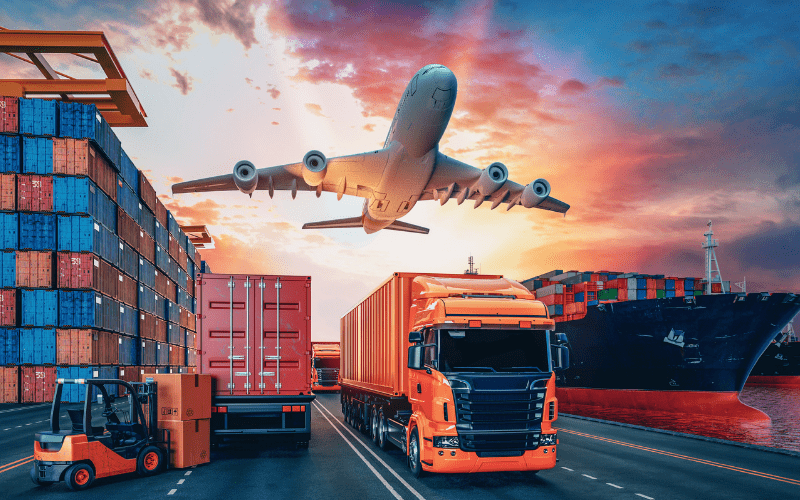The freight forwarding industry, traditionally known for its manual and paper-intensive processes, is undergoing a significant transformation. Technological advancements are reshaping how goods are transported, tracked, and managed across global supply chains. This evolution is not just enhancing efficiency but also improving transparency, security, and sustainability. Let’s explore how technology is revolutionising the freight forwarding industry.
1. Blockchain: Enhancing Transparency and Security
Blockchain technology is creating waves in the logistics sector, offering a decentralised and immutable ledger that ensures transparency and security in transactions. For freight forwarding, this means that every transaction and movement of goods can be recorded on a blockchain, making the information accessible and verifiable by all parties involved.
The benefits are manifold:
- Transparency: All stakeholders, including shippers, carriers, and customers, can access real-time data on the status of shipments. This reduces disputes and enhances trust.
- Security: Since blockchain records are immutable, they prevent fraud and tampering. This is particularly crucial for high-value or sensitive goods.
- Efficiency: Automating documentation and reducing the need for intermediaries streamline operations, cutting down costs and time.
2. Internet of Things (IoT): Real-Time Tracking and Monitoring
The Internet of Things (IoT) is revolutionising the way freight is tracked and monitored. IoT devices, such as GPS trackers and smart sensors, are being embedded in containers and vehicles to provide real-time data on the location, condition, and status of shipments.
Key advantages include:
- Real-Time Visibility: Companies can track shipments throughout the supply chain, allowing them to respond quickly to delays or issues.
- Condition Monitoring: Sensors can monitor temperature, humidity, and other conditions, ensuring that perishable or sensitive goods are transported under optimal conditions.
- Predictive Maintenance: IoT devices can also monitor the condition of vehicles and equipment, predicting maintenance needs before failures occur, thus reducing downtime and improving reliability.
3. Artificial Intelligence (AI) and Machine Learning: Optimising Operations
AI and machine learning are playing crucial roles in optimising various aspects of freight forwarding. From route planning to demand forecasting, these technologies are making operations more efficient and cost-effective.
Notable applications include:
- Route Optimization: AI algorithms can analyse multiple factors, such as traffic, weather, and fuel costs, to determine the most efficient routes. This not only saves time but also reduces fuel consumption and emissions.
- Demand Forecasting: Machine learning models can predict demand patterns based on historical data, enabling companies to plan their capacity and resources more effectively.
- Automated Documentation: AI-powered systems can automate the processing of documentation, reducing errors and speeding up customs clearance and other administrative tasks.
4. Big Data Analytics: Driving Informed Decision-Making
The freight forwarding industry generates vast amounts of data, from shipment details to customer preferences. Big data analytics allows companies to harness this data to make informed decisions and gain a competitive edge.
Benefits of big data analytics include:
- Performance Analysis: Companies can analyse performance metrics to identify inefficiencies and areas for improvement.
- Customer Insights: Analysing customer data helps in understanding preferences and behaviour, allowing for personalised services and better customer satisfaction.
- Risk Management: Predictive analytics can identify potential risks in the supply chain, enabling companies to take proactive measures to mitigate them.
5. Robotics and Automation: Enhancing Efficiency and Accuracy
Robotics and automation are increasingly being adopted in warehouses and logistics centres to enhance efficiency and accuracy. Automated systems can handle repetitive tasks such as sorting, packing, and loading, allowing human workers to focus on more complex and strategic activities.
Key benefits include:
- Increased Efficiency: Automated systems can work around the clock, significantly increasing productivity.
- Improved Accuracy: Robots are less prone to errors compared to humans, ensuring that tasks such as order fulfilment are carried out with high precision.
- Cost Savings: While the initial investment in automation technology can be high, the long-term savings in labour costs and increased efficiency often outweigh these expenses.
Conclusion
Technology is undeniably transforming the freight forwarding industry, bringing unprecedented levels of efficiency, transparency, and security. As blockchain, IoT, AI, big data, and robotics continue to evolve, they will further revolutionise how goods are moved and managed globally. Freight forwarders that embrace these technologies will not only stay competitive but also drive innovation in the logistics sector. The future of freight forwarding is undoubtedly digital, and the journey has just begun.
 عربي
عربي عربي
عربي